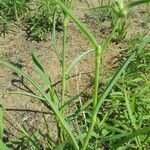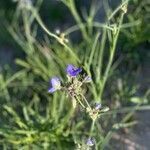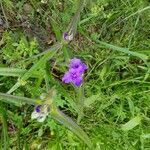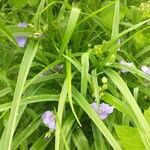Stem slender, straight, often branched, 2–6 dm at anthesis, glabrous and glaucous; lvs firm, glabrous, involute, usually narrowly linear and under 1 cm wide; bracts like the lvs; cymes solitary and terminal, or with another one peduncled from an upper node; pedicels and sep sparsely pubescent with glandular hairs 0.5 mm; sep acute to acuminate, 6–10 mm; pet rose to blue, 12–16 mm; 2n=12, 24. Dry prairies and plains; w. Wis. and Minn. to La., w. to Mont., Utah, and Tex.
A herb. The stems are 5-90 cm long. The leaves are arranged in spirals. They are narrowly sword shaped and 5-50 cm long by 0.2-3 cm wide. They taper to the tip. The flowers are blue to red and 12-16 mm long. The fruit are capsules 4-7 mm long and the seeds are 2-4 mm.





